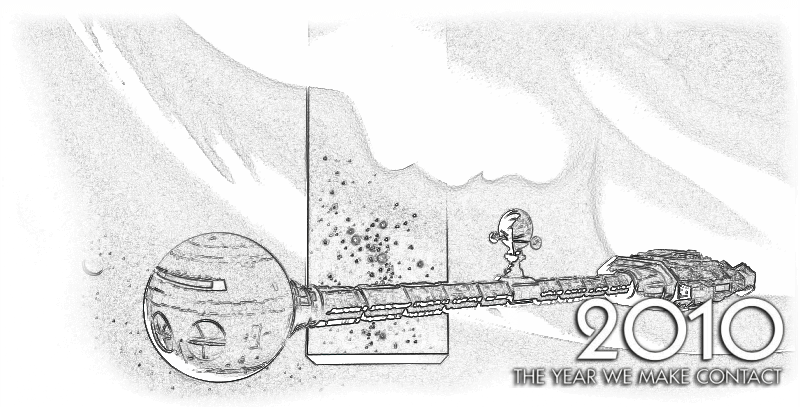 |
| Monolith action figure with almost real dimensions. |
According to Arthur Clarke's description, the monolith is a completely reflectionless, black, rectangular shape in the precise ratio of 1:4:9 - precise to the limits of measurability - and every monolith is the same size: "as large as necessary".
However, when fans of both 2001 and 2010 finally set their eyes on a monolith with the actual ratio of 1:4:9, the reaction is almost invariably the same: "that cannot be right".
Indeed, the ratio of the monoliths in either movie are not the squares of the three first natural numbers. Author Clarke stumbled upon the brilliant idea of the ratio after Kubrick had already settled on the visual appearance of the monolith. By the time Clarke realized the dimensions, the monoliths were already built and Kubrick had already shot all of the scenes involving the obsidian ingot.
Stereoliths
Director Peter Hyams had the opportunity to correct the ratio when he shot 2010, but he decided to use the same visual style as they had in 2001 for the mysterious monoliths. The reason why this happened is rather amusing.
"An interesting thing about the monolith," says 2010 matte painter Matthew Yuricich, "is that when we first started, in the script, Peter [Hyams] called for a ratio of 1:4:9 - 1 thick, 4 wide and 9 long. We did that and it looked like a cement block."
The monoliths are de facto never shown with the ratio 1:4:9. When the slabs were produced for 2010, Arthur C. Clarke had not yet made it known the revelation regarding the ratio came to him after the monoliths for 2001 had already been shot, so the accepted wisdom was that the monoliths in 2001: A Space Odyssey were indeed in the precise ratio 1:4:9. No-one knew otherwise.
It was with this assumption that director Hyams placed the order for scores of paintings of the enigmatic, murky lumps. The reason they did not appear as ordered in the motion picture is due to nothing short of mutiny.
Matthew continues: "I talked to [matte department supervisor] Neil [Krepela] about it and said: 'There's nothing to it - no aesthetics. It looks like a damned brick.' He said that was what Peter was calling for, but to go ahead a slim it down anyway - and I did."
 |
| Monolith with actual ratios. |
"And as soon as Peter [Hyams] saw it, he said, 'Go ahead and slim it down.' Actually, our proportion ended up being something like 1:4:15 or something like that, to give a little grace to it."
Having stumbled upon this eye opener, Yuricich wanted to know what the featureless bricks actually looked like in the previous movie.
"We dug up some photographs that they had of the 2001 monoliths and, my god, those were about 1 to 40! Very slim. About half the size of a domino proportion. So even though it was written to be 1:4:9, everyone seemed to realize that it wouldn't have the grace and symmetry at that exact ratio."
The conclusion is inescapable. The world of the page and the world on the silver screen are divided by ratios (pun hinted at). The ratio works much better as a poetic concept than as a visual one.
Morpholiths
As mentioned, the monoliths are not consistent between the 2001 novel and the 2001 movie, due to the events described. The black slabs are not really consistent between the 2001 and 2010 movies, either.
Strangest of all, they are not even consistent within the movies.
Some of the monoliths are wider than others, and some are differently colored. The various tints and hues could possibly be explained by the surrounding environment where the slabs reside, but it is obvious that the tinctures are merely artistic decisions. Almost all the monoliths, bar the digital depictions by Leonov's computer, are paintings. Very few models were used. The last time we set our eyes on the monolith, in the very last scene of the movie, the model is not even rectangular.
 |
| Super-wide monolith metrics in 2010. |
Since the monolith paintings were done with artistic and visual issues in mind, this results in some interesting effects. Essentially the monoliths are all different, every single one of them.
The monoliths in 2010 take on a variety of different shapes, and none of the ratios are the squares of the first natural numbers. The widest monolith in the movie is 12 times as wide as it is thick, and would probably not even classify as a monolith, but rather as a wall. We never actually see the mysterious ratio on the silver screen.
Neverliths
 |
| ThinkGeek's TMA-2 action figure: "zero points of articulation". |
Monolith Action Figure source (note: it's not real)
In the Space Odyssey myth the monoliths are apparently capable of sustaining themselves indefinitely, are impervious to any force known to Man, always maintain their dimensional ratio, are extremely flat, and so on. In contrast, in the movie universe the monoliths seem to be very flexible indeed.
At times author Clarke stated he was as perplexed by the monoliths as everyone else was, and further said that everyone else's ruminations about the nature of the blocks were almost as valid as his own. It also appeared he himself was just as baffled and surprised by the changing nature of the darkened plaques as the readers were.
Perhaps the only conclusion we can draw thereof is the monoliths never really had a set nature, not even in the mind of the author.
Maybe they, like so many other enigmas, are their own key. If so, we will probably never solve their mystery.
Images ©1984 MGM, ©2010 ThinkGeek, ©2015 Odyssey Archive.
